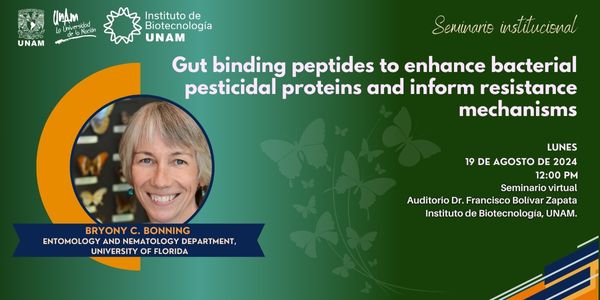
19Ago - 2024
Gut binding peptides to enhance bacterial pesticidal proteins and inform resistance mechanisms
12:00 PM - 02:00 PM|Dra. Bryony C. Bonning|Entomology and Nematology Department, University of Florida|Invitado por: Dres. Mario Soberón y Alejandra Bravo
Seminario
Short peptides that bind to the insect gut have a wide range of uses. In addition to their use for blocking pathogen binding to the insect gut, they can also be used to 1) identify pathogen binding domains based on amino acid sequence similarity, 2) identify candidate pathogen receptor proteins, and 3) as artificial anchors to increase the binding and toxicity of bacteria-derived pesticidal proteins (BPP). In this talk, Bonning will describe how gut binding peptides have been used to improve the insecticidal efficacy of three BPP from different structural classes, and how these peptides can also provide insight into BPP resistance mechanisms.
Los péptidos cortos que se unen al intestino de los insectos tienen un amplio rango de usos. Además de su uso para bloquear la unión de patógenos al intestino de los insectos, también pueden ser usados para 1) Identificar dominios de unión de patógenos basados en similitud de secuencia de aminoácidos, 2) identificar candidatos de proteínas receptoras de patógenos, y 3) como anclas artificiales para incrementar la unión y toxicidad de proteínas pesticidas derivadas de bacterias (BPP). En esta plática, la Dra. Bonning describirá cómo los péptidos de unión a intestino han sido usados para mejorar la eficiencia insecticida de tres BPP de diferentes clases estructurales, y cómo estos péptidos también pueden dar indicios de los mecanismos de resistencia a BPP.
Actualizado 2024-08-13 17:23:10



